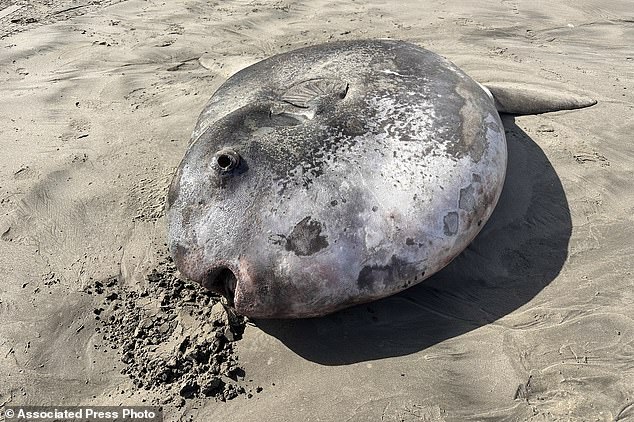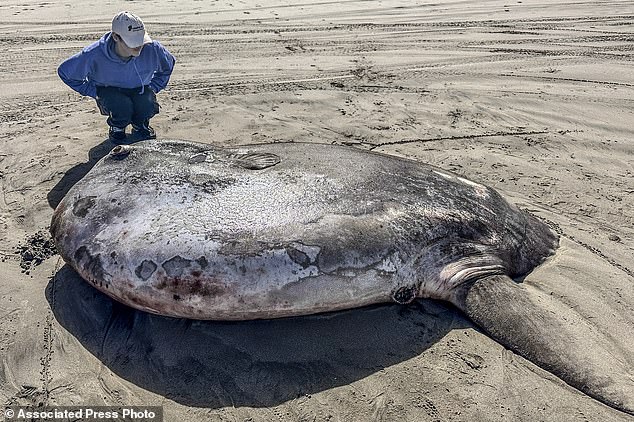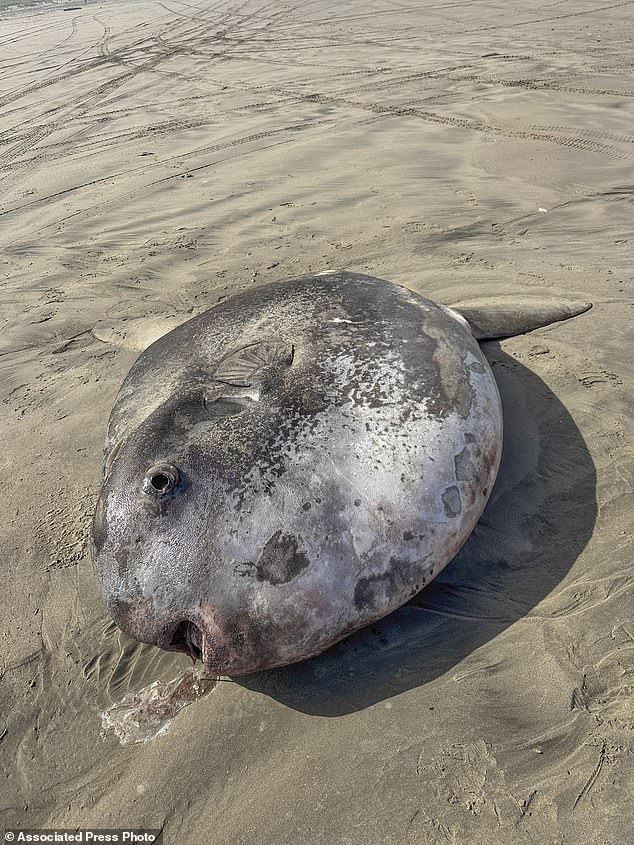A giant fish the size of a golf cart washes up on an Oregon beach
A 7-foot-long specimen of a giant fish that can grow to more than two tons has washed up at a beach town in Oregon — far north of the warm waters it usually calls home.
Marine scientists at Gearhart identified the giant fish as a “hoodwinker sunfish,” a new species only discovered in 2017 because its appearance is deceptively similar to the “ocean sunfish.”
Representatives of Gearhart’s Seaside Aquarium said the stranded hoodwinker will “probably remain for a few more days, maybe weeks,” because the tough skin of this sea creature’s carcass makes it virtually impenetrable to scavengers.
“It was called a new species hiding in plain sight, but genetic sampling and eventual observation contributed to its discovery,” the aquarium noted in a statement.
A 7-foot-long specimen of a giant ‘hoodwinker sunfish,’ which can grow more than two tons, has washed up along a coastal town in Oregon – far north of the warm waters it usually calls home

These images, courtesy of Seaside Aquarium, show the sunfish that washed up along the beach in Gearhart, Oregon on June 3, 2024
The huge rare fish has attracted crowds of onlookers intrigued by the unusual spectacle.
‘This large, strange looking fish caused quite a stir on social media and even though it was storming, people flocked to the beach to see this unusual fish,’ Representative of the Seaside Aquarium posted on Facebook.
Photos taken by aquarium staff documented the hoodwinker’s flat, round and mottled gray appearance as the beached fish rested on its side in the sand.
Photos were also taken of the large dead fish next to a person and a pickup truck, helping to better understand the incredible size of the sunfish.
The social media frenzy over the stranded creature led the Danish marine biologist, who first discovered the hoodwinker species about seven years ago, to reach out in an attempt to help confirm what type of sunfish had washed ashore.

Photos taken by aquarium staff documented the hoodwinker’s flat, round and mottled gray appearance as the beached fish rested on its side in the sand

Photos were also taken of the large dead fish next to one person and a pickup truck, better showing the incredible size of this sunfish.
New Zealand marine biologist Dr. Marianne Nyegaard requested “samples for genetics,” according to the aquarium, which provided “more photos, measurements and tissue samples.”
But just from the photos, Dr Nyegaard was able to confirm that it was not only a sunfish, but also a sunfish may be the largest specimen ever sampled.
In research published in 2017, Nyegaard discovered through genetic sampling and observation that the sunfish, or ‘Mola tecta’, was a different species from the ocean sunfish, ‘Mola mola’.
‘Tecta’ means hidden or disguised in Latin, referring to a new species that had hidden in plain sight.

“Sunfish are not particularly rare, but they are difficult to study because they simply live in parts of the ocean where most people don’t go,” said New Zealand-based marine biologist Dr. Marianne Nyegaard, who was the first to discovered the species. hoodwinker strains in 2017
Speak with The conversation, Shortly after her discovery in 2017, Dr. Nyegaard that ‘unraveling this mystery was a huge puzzle.’
“Sunfish are huge, largely solitary and quite elusive,” she explained, “so you can’t just go out and sample a bunch of them to study.”
“Sunfish are not particularly rare, but they are difficult to study because they simply live in parts of the ocean where most people don’t go,” she noted.
‘They dive hundreds of meters to feed and then come to the surface to bask on their sides in the sun, hence their name.’
In recent years, a few more rare cases have emerged of sunfish washing up on the coasts of California and Alaska, both further from their more tropical or temperate ocean habitats than previously thought possible.
“This fish, hiding in plain sight, has most likely been seen before (or) washed up in the Pacific Northwest,” Gearhart’s Seaside Aquarium said, “but was mistaken for the more common Mola Mola.”
